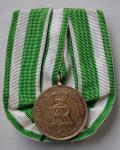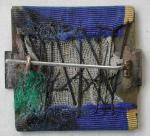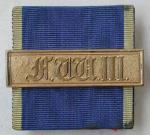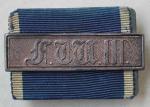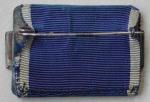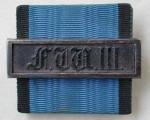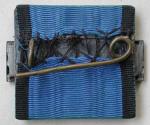-
Posts
949 -
Joined
-
Last visited
Content Type
Profiles
Forums
Blogs
Gallery
Events
Store
Everything posted by David Gregory
-
I know that certain members here seem to have an uncanny knack of identifying otherwise anonymous medal bars to put a name to a face in a photograph. This image was taken by a photographer in Minden, the garrison town of 26. Infanterie-Brigade, Infanterie-Regiment 55 and Feldartillerie-Regiment 58 among others, and bears a faint comment in pencil on the back. The comment reads: "Taken on 1st August, one day before departing in field grey uniform. For the 5th September 1914". Despite the fact that the bar only has four awards with which the officer shown might be identified, is this combination enough? The Centenary medal, SEHO and Lippe-Detmold Honour Cross of the House Order seem obvious to me, but I cannot identify the fourth cross, which is the only one with swords. He was in service in 1897, received two house orders without swords, presumably for peacetime service, and I assume the fourth award was for service involving some sort of action. China or South-West Africa spring to mind, but are these precluded by the lack of awards for service in China or Africa? Might they have been added later considering that this bar may have been put together as late as mid 1914? Medal bar detail: For what it is worth, the shoulder strap in detail: Was he a Saxon on loan to a Lippe regiment? Why is he not wearing any service award (1897-1914)? What can the rank list and medal bar experts come up with? Thanks for your comments in advance, David
-
The court mount from the back showing the typical Saxon ribbon folding style: [attachmentid=15076] The back of the medal: [attachmentid=15078] Andreas Schulze Ising has a good article on the Saxon service awards on his site at http://www.medalnet.net/. I am sure I have some award documents for the Prussian bars, but seem to have misplaced them. Does anyone have examples of the award documents for the Saxon bars and medals? David
-
When the Prussians replaced their bars with medals and crosses in 1913, the Saxons followed suit and the bar shown above was replaced by a medal according to the statute of 6 September 1913. The ribbon remained the same as for the Schnalle. The medal was made of copper and seems to be plated. Many owners of the Schnalle purchased the medal and wore it instead. The shape, size and script is much the same as the Prussian Landwehr service medal. Although it doesn't really belong in this thread (i.e. it is not a bar), I am posting this example of a single court-mounted medal for the sake of continuity. [attachmentid=15075]
-

Let us see those Riders Badges
David Gregory replied to Paul R's topic in State, Civil Awards & Decorations
Tony, Aren't they still issued like this? I am sure one the "horse crowd" has shown one of these in the office recently. David -
Dave, Thanks for your comments. Since most of the paperwork I have relates to enlisted men and NCOs, with only a few officers, I am trying to distinguish between the "low-end" awards and avoid having to write them all out in full. At the same time, I would like to use generally accepted and commonly used abbreviations for the sake of consistency with contemporary literature. Incidently, for the Bremen Hanseatenkreuz I probably have paperwork for about 7 or 8 men in the form of loose award documents and various entries in Milit?rp?sse and Soldb?cher. It still remains one of the least common awards among some 400 men whose paperwork I have. David
-

"Dotted" date Zimmermann DKiG's
David Gregory replied to Dave B's topic in State, Civil Awards & Decorations
I offer my apologies for straying off topic. Like many others (I suspect), I know too little about these pieces to make a decision with any confidence. Although I am unlikely ever to acquire one (but never say never), I would like to know more about them and be able to form an opinion of my own. -

"Dotted" date Zimmermann DKiG's
David Gregory replied to Dave B's topic in State, Civil Awards & Decorations
Differences to a known original might indicate that the piece is a fake, however, they might equally indicate that the piece is simply as yet unknown. By your reasoning, anything which is different and unknown is a fake. Of course I agree that there are poor fakes that are likely to fool only complete beginners, but I cannot automatically condemn things out of hand just because I have not seen one before. I did not state that an item is only a fake if it is known to come from a bad source, I did state that there can be no doubt about it in such cases. I agree that the vast majority of fakes are of (to us) unknown origin. In my view, that does not automatically make any item of unknown origin a fake. My statement was not an absolute ruling on what is and is not a fake. As I am not an expert by any stretch of the imagination, I would assume that the experts (whoever they may be) are probably right. My criteria do not dictate that a previously unknown and "different" item is real. I simply believe that logic dictates that it might just as easily be real as well as fake. Both are very real possibilities, neither of which I would discard out of hand. A scientific approach (with or without laboratory equipment) is laudable and helps to provide evidence for or against a particular item. To be honest, I stopped following the debate on the rounder when, in my view, conclusions were drawn on the basis of flawed logic despite the presentation of apparently sound scientific evidence. Unfortunately, the issue seems to remain highly subjective. In my view, conclusions can only be cut and dried when we know all the facts. However unpalatable it may be for some people, I don't think we ever will know all the facts. For that reason, I prefer to steer clear of something that I will never be sure of. If someone else wants to make the leap of faith and is satisfied with what is known so far, then that is his choice. Yes, we can agree that it is different. I am not disputing the fact that it might be bad. However, I think we disagree that this automatically condemns it as a fake, the possibility of which I will not rule out. Despite what dealers tell me, I still have the choice not to buy their goods. Perhaps Ivan or Pieter know something that the rest of us don't. The body of opinion (evidence?) presented so far suggests that these items are not good, which certainly puts me off even considering buying one. Given the risks involved in investing in a DK, I would only ever consider one with sound provenance. If that means that I will probably never be able to find or afford one, then I will happily do without a DK and stick to Imperial documents. But that is my choice. David -
Thanks for the additions Rick. Do you also have abbreviations for the following: Hessen Kriegsehrenzeichen Hohenzollern silberne/goldene Ehrenmedaille mit Schwertern Lippe-Detmold Kriegsehrenmedaille Lippe-Detmold Milit?rverdienstmedaille Sachsen Albrechtskreuz (with and without swords) in silver Sachsen gold and silver medals of the Saint Henry Order I also have a document to another Schwarzburg award the name of which escapes me at the moment, but I'll add it over the weekend. Is there a general convention on how to indicate awards on non-combatant ribbons or did each state do its own thing? It might be arcane gibberish to some people, but I am slowly understanding all of these awards even better. This will certainly go a long way to replace the pages explaining the abbreviations that were removed from my 1912 rank list. Once again, many thanks in advance, David
-
Bob, I think this is one (probably the second) of two types of Prussian 3rd class award issued between 1825 and 1913 for 9 years of service in the regular army. The Landwehr version is similar, but not the same. Like the second (silver for 12 years) and third (gold for 15 years) classes, this style of award was replaced by the round medals (9 and 12 years service) and crosses (15 years service) that are more commonly seen on medal bars from 1913 until 1920. Christian shows the second class award in post #4 and Tom shows all three classes in post #7 together with a Landwehr award (centre right). David
-
Specifically, the list lacks "low-end" awards for at least the following: Anhalt Thuringian duchies' own awards Baden Mecklenburg-Strelitz Sachsen-Weimar Hohenzollern Reuss Lippe-Detmold Schaumburg-Lippe Schwarzburg Waldeck Any help would be greatly appreciated, as cataloguing award documents, Soldb?cher and Milit?rp?sse with the full names of the "minor" awards will otherwise take me years. I would like to use a set of abbreviations that were either commonly used in the various rank lists or something very similar. Thanks, David
-

"Dotted" date Zimmermann DKiG's
David Gregory replied to Dave B's topic in State, Civil Awards & Decorations
I can't discuss the specifics of the Klein pieces, or any other DKs for that matter, because I don't know enough about them (yet, I hope). When the sources and suppliers of items such as the Latvian RKs are known, then there is no doubt about them being generally accepted as fakes. There is an enormous spectrum between known fakes (e.g. Latvian RKs) and pieces that cannot be proved to be bad, but which most serious collectors avoid like the plague. Between and beyond those two poles there are almost certainly items that are in fact fakes, but not recognised or generally accepted as such, and may remain undiscovered for a long time (forever even?). By the same token, there are almost certainly authentic items that have been discussed and contended to the point where no one wants to have them, even if they are good. While I can't argue for or against the Klein DKs you discuss here, I am not prepared to dismiss them out of hand because they don't fit the little information that I accept as reliable. Perhaps some changes were made on a whim, or for reasons we will never know. Neither you nor I, unless one of us knows something the rest of the world does not, can give a reason why one manufacturer made changes, but another did not. As far as I am concerned, there is not enough reliable information available on these pieces to make a decision either way. Until more comes to light, I prefer to regard them with the same suspicion as other expensive Third Reich awards - they are prone to much faking and I refuse to treat them as cut and dried. We simply don't have enough information and comparisons and speculation about them will remain just that. I accept fakes known to have been made and supplied by a purveyor of fakes. I also accept original items known to have come from the men (or their families) that received them. Within certain limits (my own definition), I will also accept items identical to the latter with a certain margin of deviation. All the rest remains very much a grey area - we will probably never know. That is why I mainly stick to inexpensive Imperial documents and awards that give me hours of research pleasure, rather than worrying about an anonymous piece of metal that I can never be sure about. Each of us must make his own decision about what he is prepared to accept as real (by your definition no different to what you are happy with). Other collectors, and dealers for that matter, may or may not agree with you, but that is their choice. Collecting militaria is not an exact science and absolutes tend to be more a matter of opinion rather than fact. -
Dave, That is a great piece of work. I am in the process of cataloguing my documents so that I know what I have and who served with a particular unit at a given time. One problem I have encountered is how to designate the various awards (primarily common awards from the various states to enlisted men and junior officers). Are the abbreviations you use standardised in any way and do you know of accepted abbreviations for the EK "equivalents" (for want of a better word), e.g. Saxon bronze and silver FAM, Baden merit medal, Braunschweig 1st and 2nd class war merit cross, etc.? David
-

"Dotted" date Zimmermann DKiG's
David Gregory replied to Dave B's topic in State, Civil Awards & Decorations
I don't know enough about the pieces in question to make a qualified comment on them, which is why I am trying to learn. However, I cannot accept your conclusion that a change in manufacturing methods, which we will probably never be able to understand, automatically condemns an item as a fake. I work for an engineering company in which minor changes are made to products on a regular basis. In 10 years from now, I defy anyone to explain why some of them occured, unless you have access to the design and quality assurance documents that we have to keep on file. Although I accept the possibility that unexplained differences might be due to fakes, it seems to me that any other explanation is simply disregarded in order to support the "fake" argument. Some of the known and accepted facts (e.g. differences) might support the fake theory, but there may well be a huge amount of information that has been lost, or not yet discovered, that would defeat it or support a quite diffferent conclusion. Unfortunately, there seem to be few, if any, known records of the various manufacturers still available today and the eye witnesses to the production processes probably died some years ago. I applaud the questioning of items that seem genuinely suspicious (and turn out to be fakes), but there may any number of reasons why changes occured and we might not ever learn why. There may be no conclusive answer, however unpalatable that may seem to people who have a lot of money at stake. -
Dave, Thanks for the corrections. I'll incorporate them into my list when you have posted them all. The list I have is very basic and compiled in Access, which allows it to be sorted at will. Please let me know if it is of any use to you and I can send it to you in that or a similar format (Excel or HTML) to save duplicating the work. Cheers, David
-

"Dotted" date Zimmermann DKiG's
David Gregory replied to Dave B's topic in State, Civil Awards & Decorations
Like Rick, I am not really prepared to spend so much money on something made to fool collectors. Please show this fake and tell us why some Klein-made examples are accepted, and others are considered to be bad. If different = fake, how can a real variant be accepted as such? Are these definitions so absolute? Have all of these different pieces appeared only recently or is it possible that there are some in older collections that the majority of collectors who visit forums such as this do not know about? Surely not every surviving piece is in a well-known collection, or is every surviving example known and documented? Why do they have state why it is true? I can't follow your conclusion. As far as I am concerned, you have certainly demonstrated that two items display differences. That might be because one of them is a fake, or do you know some reason why they cannot possibly differ and still be right? Until someone provides reasonable evidence that these pieces have only just started appearing and that they are definitely fakes, I find it very hard to believe that there is a conspiracy by a group of such prominent and closely watched dealers to rob otherwise poverty-stricken collectors who just have to acquire an example of every high-end award under the sun. The paranoia and price hype attached to these items is one of the reasons why I gave up on Third Reich awards some time ago. That being said, I would still like to keep an open mind and find out more about the pieces without having to invest a small fortune in something that involves such a potentially huge risk. David -
I bought it at a show in Germany, but I can't remember where (I have the details on file). The seller had a lot of common Baden items and a good selection from the other Imperial states. He suggested it was a late-war piece or Spangenst?ck and other collectors who have examined it in hand feel it is OK. After comparing it with one of the cheap G?de copies and a rather poor quality version that looked OK on both sides from a distance, but didn't stand up to closer scrutiny, I feel it is either a late-war piece as described, or perhaps a Spangenst?ck from the inter-war period. It displays the sort of wear that suggests that it was worn more than once. Considering the ease with which awards can be swapped around with this type of medal bar and the fact that the bar seems to be in better condition than the Z?hringer L?we, I suspect the order was added to it more recently. It is not the nicest example I have ever seen, but I am happy with it (or will be unless someone definitely identifies it as bad). David







